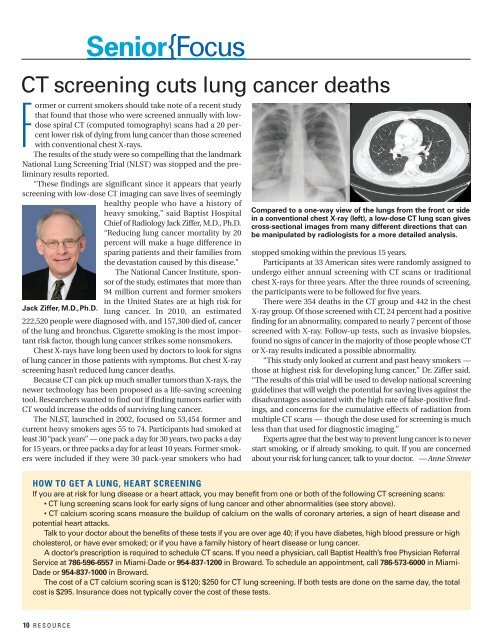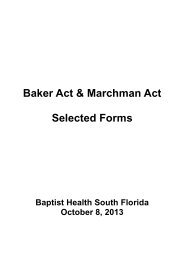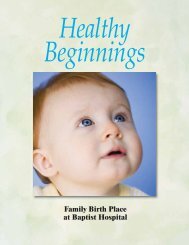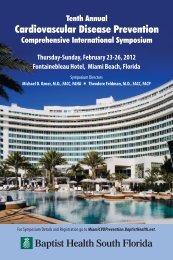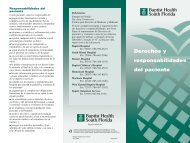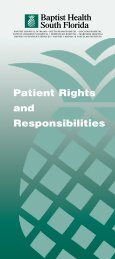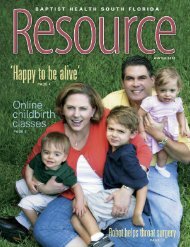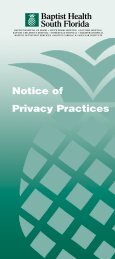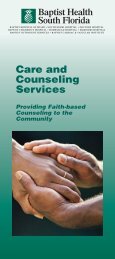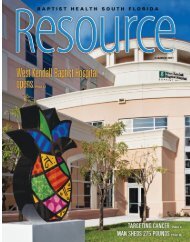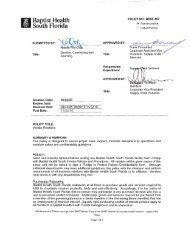SPRING 2011 - Baptist Health South Florida
SPRING 2011 - Baptist Health South Florida
SPRING 2011 - Baptist Health South Florida
You also want an ePaper? Increase the reach of your titles
YUMPU automatically turns print PDFs into web optimized ePapers that Google loves.
Senior{Focus<br />
CT screening cuts lung cancer deaths<br />
Former or current smokers should take note of a recent study<br />
that found that those who were screened annually with lowdose<br />
spiral CT (computed tomography) scans had a 20 percent<br />
lower risk of dying from lung cancer than those screened<br />
with conventional chest X-rays.<br />
The results of the study were so compelling that the landmark<br />
National Lung Screening Trial (NLST) was stopped and the preliminary<br />
results reported.<br />
“These findings are significant since it appears that yearly<br />
screening with low-dose CT imaging can save lives of seemingly<br />
healthy people who have a history of<br />
heavy smoking,” said <strong>Baptist</strong> Hospital<br />
Chief of Radiology Jack Ziffer, M.D., Ph.D.<br />
“Reducing lung cancer mortality by 20<br />
percent will make a huge difference in<br />
sparing patients and their families from<br />
the devastation caused by this disease.”<br />
The National Cancer Institute, sponsor<br />
of the study, estimates that more than<br />
94 million current and former smokers<br />
in the United States are at high risk for<br />
Jack Ziffer, M.D.,Ph.D.<br />
lung cancer. In 2010, an estimated<br />
222,520 people were diagnosed with, and 157,300 died of, cancer<br />
of the lung and bronchus. Cigarette smoking is the most important<br />
risk factor, though lung cancer strikes some nonsmokers.<br />
Chest X-rays have long been used by doctors to look for signs<br />
of lung cancer in those patients with symptoms. But chest X-ray<br />
screening hasn’t reduced lung cancer deaths.<br />
Because CT can pick up much smaller tumors than X-rays, the<br />
newer technology has been proposed as a life-saving screening<br />
tool. Researchers wanted to find out if finding tumors earlier with<br />
CT would increase the odds of surviving lung cancer.<br />
The NLST, launched in 2002, focused on 53,454 former and<br />
current heavy smokers ages 55 to 74. Participants had smoked at<br />
least 30 “pack years” — one pack a day for 30 years, two packs a day<br />
for 15 years, or three packs a day for at least 10 years. Former smokers<br />
were included if they were 30 pack-year smokers who had<br />
Compared to a one-way view of the lungs from the front or side<br />
in a conventional chest X-ray (left), a low-dose CT lung scan gives<br />
cross-sectional images from many different directions that can<br />
be manipulated by radiologists for a more detailed analysis.<br />
stopped smoking within the previous 15 years.<br />
Participants at 33 American sites were randomly assigned to<br />
undergo either annual screening with CT scans or traditional<br />
chest X-rays for three years. After the three rounds of screening,<br />
the participants were to be followed for five years.<br />
There were 354 deaths in the CT group and 442 in the chest<br />
X-ray group. Of those screened with CT, 24 percent had a positive<br />
finding for an abnormality, compared to nearly 7 percent of those<br />
screened with X-ray. Follow-up tests, such as invasive biopsies,<br />
found no signs of cancer in the majority of those people whose CT<br />
or X-ray results indicated a possible abnormality.<br />
“This study only looked at current and past heavy smokers —<br />
those at highest risk for developing lung cancer,” Dr. Ziffer said.<br />
“The results of this trial will be used to develop national screening<br />
guidelines that will weigh the potential for saving lives against the<br />
disadvantages associated with the high rate of false-positive findings,<br />
and concerns for the cumulative effects of radiation from<br />
multiple CT scans — though the dose used for screening is much<br />
less than that used for diagnostic imaging.”<br />
Experts agree that the best way to prevent lung cancer is to never<br />
start smoking, or if already smoking, to quit. If you are concerned<br />
about your risk for lung cancer, talk to your doctor. — Anne Streeter<br />
HOW TO GET A LUNG, HEART SCREENING<br />
If you are at risk for lung disease or a heart attack, you may benefit from one or both of the following CT screening scans:<br />
• CT lung screening scans look for early signs of lung cancer and other abnormalities (see story above).<br />
• CT calcium scoring scans measure the buildup of calcium on the walls of coronary arteries, a sign of heart disease and<br />
potential heart attacks.<br />
Talk to your doctor about the benefits of these tests if you are over age 40; if you have diabetes, high blood pressure or high<br />
cholesterol, or have ever smoked; or if you have a family history of heart disease or lung cancer.<br />
A doctor’s prescription is required to schedule CT scans. If you need a physician, call <strong>Baptist</strong> <strong>Health</strong>’s free Physician Referral<br />
Service at 786-596-6557 in Miami-Dade or 954-837-1200 in Broward. To schedule an appointment, call 786-573-6000 in Miami-<br />
Dade or 954-837-1000 in Broward.<br />
The cost of a CT calcium scoring scan is $120; $250 for CT lung screening. If both tests are done on the same day, the total<br />
cost is $295. Insurance does not typically cover the cost of these tests.<br />
10 RESOURCE


